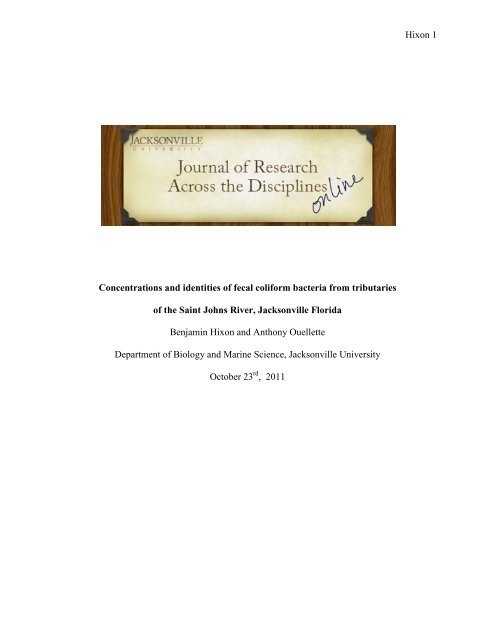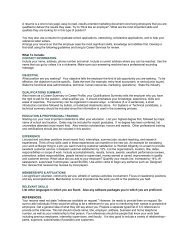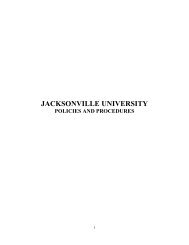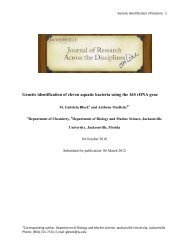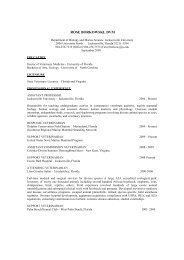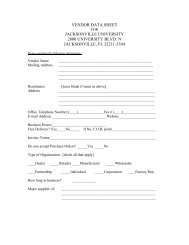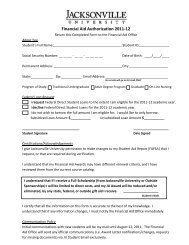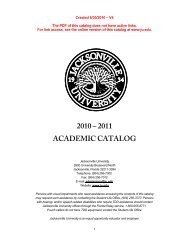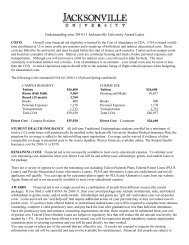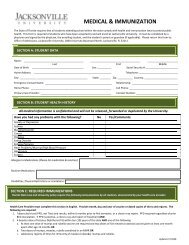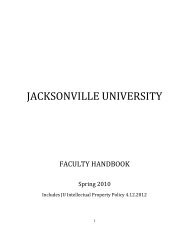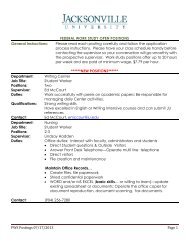Hixon 1 Concentrations and identities of fecal coliform bacteria from ...
Hixon 1 Concentrations and identities of fecal coliform bacteria from ...
Hixon 1 Concentrations and identities of fecal coliform bacteria from ...
Create successful ePaper yourself
Turn your PDF publications into a flip-book with our unique Google optimized e-Paper software.
<strong>Hixon</strong> 1<br />
<strong>Concentrations</strong> <strong>and</strong> <strong>identities</strong> <strong>of</strong> <strong>fecal</strong> <strong>coliform</strong> <strong>bacteria</strong> <strong>from</strong> tributaries<br />
<strong>of</strong> the Saint Johns River, Jacksonville Florida<br />
Benjamin <strong>Hixon</strong> <strong>and</strong> Anthony Ouellette<br />
Department <strong>of</strong> Biology <strong>and</strong> Marine Science, Jacksonville University<br />
October 23 rd , 2011
<strong>Hixon</strong> 2<br />
ABSTRACT<br />
Over the centuries humans have impacted many streams <strong>and</strong> rivers in Florida causing<br />
many <strong>of</strong> them to become polluted. Fecal <strong>coliform</strong> <strong>bacteria</strong>, which live in the guts <strong>of</strong> warm<br />
blooded animals, are common in polluted streams <strong>and</strong> rivers <strong>and</strong> are currently used as indicators<br />
<strong>of</strong> the presence <strong>of</strong> human pathogenic microorganisms. There are over 100 tributarites that flow<br />
into the Saint Johns River in Jacksonville Florida that are monitored for <strong>fecal</strong> <strong>coliform</strong> <strong>bacteria</strong>.<br />
According to the Florida Department <strong>of</strong> Environmental Protection (FDEP) if there are more than<br />
800 <strong>fecal</strong> <strong>coliform</strong> colony forming units (CFUs) per 100mL, the water is deemed not safe for<br />
human recreation. This paper focuses on descriptive <strong>and</strong> comparative research at six sites along<br />
the Saint Johns River near Jacksonville University (JU). The <strong>fecal</strong> <strong>coliform</strong> <strong>bacteria</strong> ranged <strong>from</strong><br />
1 to 1067 CFUs/100mL, with the highest counts at Jacksonville University. There were no<br />
apparent relationships seen between <strong>fecal</strong> <strong>coliform</strong> <strong>bacteria</strong> CFUs <strong>and</strong> water temperature,<br />
dissolved oxygen, salinity, <strong>and</strong> pH. Common <strong>fecal</strong> <strong>coliform</strong> <strong>bacteria</strong> belonging to the genera<br />
Escherichia, Klebsiella, <strong>and</strong> Citrobacter were identified.<br />
INTRODUCTION<br />
Water quality is a serious issue that affects many U.S. streams <strong>and</strong> rivers, including the<br />
Saint Johns River in Jacksonville Florida. According to a report by Lui et al. (2010) that assessed<br />
39% <strong>of</strong> the United States streams <strong>and</strong> rivers, 19% were found to be impaired, <strong>of</strong> which 35%<br />
percent were polluted by <strong>fecal</strong> <strong>coliform</strong> <strong>bacteria</strong>. Fecal <strong>coliform</strong> <strong>bacteria</strong> are listed as the leading<br />
causes <strong>of</strong> water quality impairment in rivers <strong>and</strong> streams <strong>and</strong> the second leading cause in<br />
estuaries (Liu et al. 2010).
<strong>Hixon</strong> 3<br />
Fecal <strong>coliform</strong> <strong>bacteria</strong> are part <strong>of</strong> the gut flora <strong>of</strong> warm blooded animals <strong>and</strong> are<br />
commonly used as indicators <strong>of</strong> the presence <strong>of</strong> <strong>fecal</strong> material <strong>and</strong> sewage contamination<br />
(Toothman et. al. 2009). Water that contains contaminants <strong>from</strong> <strong>fecal</strong> material <strong>from</strong> warm<br />
blooded animals is likely to have human pathogenic microorganisms (Messyasz et al. 2010).<br />
Fecal <strong>coliform</strong> pathogens can become problematic if the water is unfiltered <strong>and</strong> used for<br />
recreational activities, shellfish harvesting, irrigation, <strong>and</strong> drinking water production (Servais et<br />
al. 2009).<br />
It has been proposed that <strong>fecal</strong> <strong>bacteria</strong> concentrations are enhanced by increased<br />
phosphorus concentrations. Burkholder et al. (2007) <strong>and</strong> Mallin et al. (2009) suggested that there<br />
is a positive correlation between <strong>fecal</strong> <strong>bacteria</strong> <strong>and</strong> nutrient concentrations due to either a<br />
common source or a r<strong>and</strong>om arrival <strong>of</strong> nutrients <strong>and</strong> <strong>fecal</strong> <strong>bacteria</strong> in one region. However,<br />
Sheheta et al. (1971) found that in areas with low nutrient concentrations <strong>fecal</strong> <strong>coliform</strong> <strong>bacteria</strong>,<br />
specifically E. coli, were dependent on phosphorus concentrations. Researchers <strong>from</strong> the<br />
University <strong>of</strong> North Carolina Wilmington continuously monitored water <strong>from</strong> the Bradley Creek<br />
watershed for 11 years; during a time <strong>of</strong> continuously high <strong>fecal</strong> <strong>coliform</strong> concentrations, urban<br />
storm water run<strong>of</strong>f was identified as the major contributor <strong>of</strong> <strong>fecal</strong> <strong>coliform</strong> <strong>bacteria</strong> to the<br />
watershed (Toothman et. al. 2009).<br />
Fecal <strong>coliform</strong> <strong>bacteria</strong> that are antibiotic resistant have also been isolated <strong>from</strong> river<br />
water near wastewater treatment plants. Microbial source tracking is typically used to track<br />
antibiotic resistance patterns <strong>of</strong> <strong>fecal</strong> <strong>bacteria</strong> to find the origin <strong>of</strong> the <strong>fecal</strong> pollution within<br />
specific aquatic environments. Servais et al. (2009) investigated antibiotic resistance <strong>of</strong> the <strong>fecal</strong><br />
<strong>coliform</strong> <strong>bacteria</strong> Escherichia coli <strong>and</strong> intestinal enterococci isolated <strong>from</strong> the Seine River<br />
watershed using the disk diffusion method. It was found that 43% <strong>of</strong> the sampled E. coli <strong>and</strong>
<strong>Hixon</strong> 4<br />
83% <strong>of</strong> the intestinal enterococci were resistant to at least one antimicrobial agent (Servais et al.<br />
2009). In fact, most E. coli are resistant to multiple antimicrobial agents due to the pumps in their<br />
outer membrane (Musgrove et al. 2006).<br />
Fecal <strong>coliform</strong> <strong>bacteria</strong> are found in the Saint Johns River <strong>and</strong> its surrounding tributaries<br />
because <strong>of</strong> failing septic tanks, wastewater treatment plants, broken sewer lines, <strong>and</strong> animal<br />
waste (St. Johns River Keeper 2011). The Saint Johns River is a diverse ecosystem with slowly<br />
moving water that historically has had a lot <strong>of</strong> pollution problems; however, since the mid 1970’s<br />
<strong>and</strong> the creation <strong>of</strong> the clean water act <strong>of</strong> 1972, community efforts <strong>and</strong> initiatives addressing the<br />
<strong>bacteria</strong>l sources have improved the overall quality <strong>of</strong> the river (Hollingsworth 2007). The major<br />
sources <strong>of</strong> pollutants, such as <strong>fecal</strong> <strong>coliform</strong> <strong>bacteria</strong>, are discharges <strong>from</strong> wastewater treatment<br />
plants <strong>and</strong> water run<strong>of</strong>f caused by rain (SJRWMD 2011). The root <strong>of</strong> the problem comes <strong>from</strong><br />
nutrients <strong>and</strong> chemical contaminants that enter the river as either point-source or non-point<br />
source discharges. Point source discharges include domestic <strong>and</strong> industrial wastewater treatment<br />
plants, <strong>and</strong> usually enter the river through a man-made pipe or channel. The Saint Johns River is<br />
also affected by non-point source discharges which include septic tank leaching, ground water<br />
intrusion, run<strong>of</strong>f <strong>from</strong> roads <strong>and</strong> highways, pasture l<strong>and</strong>s <strong>and</strong> forestry, <strong>and</strong> storm water collection<br />
systems which have no fixed entry point, making it difficult to find the main source <strong>of</strong> the<br />
pollution (Maher 2007). Algal blooms, which have detrimental effects on aquatic ecosystems,<br />
have the ability to form in the Saint Johns River due to the rivers warm water temperature <strong>and</strong><br />
high level <strong>of</strong> excess nutrients, such as phosphorus <strong>and</strong> nitrogen, <strong>from</strong> both point source <strong>and</strong> nonpoint<br />
source discharges (Cadenhead 2007).<br />
The city <strong>of</strong> Jacksonville Florida (COJ) monitors over one-hundred tributaries belonging<br />
to the Saint Johns River on a quarterly basis. The tributaries are measured for dissolved oxygen
<strong>Hixon</strong> 5<br />
levels, <strong>fecal</strong> <strong>coliform</strong> <strong>bacteria</strong> concentrations, <strong>and</strong> other st<strong>and</strong>ards <strong>of</strong> water quality. According to<br />
Florida State st<strong>and</strong>ards, if a body <strong>of</strong> water contains 800 or more <strong>fecal</strong> <strong>coliform</strong> colony forming<br />
units (CFUs) per 100mL, then the water is deemed not safe for human recreational activities like<br />
fishing, <strong>and</strong> swimming (Tributary program 2011).<br />
This paper describes descriptive <strong>and</strong> comparative research on total <strong>bacteria</strong> <strong>and</strong> <strong>fecal</strong><br />
<strong>coliform</strong> <strong>bacteria</strong> concentrations in tributaries that flow into the St. Johns River at or within a<br />
close vicinity <strong>of</strong> Jacksonville University. Fecal <strong>coliform</strong> <strong>bacteria</strong> CFUs were measured at four<br />
sites currently being measured by the city <strong>of</strong> Jacksonville (COJ) <strong>and</strong> at two other sites on the<br />
Jacksonville University Campus that were not previously monitored. Dissolved oxygen, pH,<br />
salinity, <strong>and</strong> water temperature were measured at all sites during both sample collections. The<br />
resulting data was compared to <strong>fecal</strong> <strong>coliform</strong> CFUs for both collections at all the sample sites in<br />
search <strong>of</strong> potential relationships.<br />
METHODS<br />
Six sampling locations at Jacksonville University in Jacksonville, FL or within a few<br />
miles <strong>of</strong> the university were monitored (figure1). All water samples were collected <strong>from</strong> either<br />
the Saint Johns River or surrounding tributaries. Four <strong>of</strong> the six samples (LB1, DR1, ALR7,<br />
ARL3) were tributary sites already being monitored quarterly by the city <strong>of</strong> Jacksonville <strong>and</strong> two<br />
(JU1, JU2) were not previously monitored <strong>and</strong> on the Jacksonville University campus. The order<br />
for both sampling collections was consistent <strong>and</strong> in the order: LB1, DR1, JU2, JU1, ARL7,<br />
ARL3. JU2 is the only sample site that is in the St. Johns River. For the sites that were<br />
previously monitored, data <strong>and</strong> results are available <strong>from</strong> the city <strong>of</strong> Jacksonville’s tributary<br />
monitoring website for February to March 2009 (Tributary program 2011).
<strong>Hixon</strong> 6<br />
NAME<br />
OF<br />
SAMPLE<br />
AREA<br />
LB1<br />
DR1<br />
JU2<br />
JU1<br />
ARL7<br />
ARL3<br />
LOCATION<br />
Long Branch at Wigmore Street<br />
Deer Creek at Talleyr<strong>and</strong> Avenue<br />
JU boathouse dock<br />
Creek/pipe run<strong>of</strong>f at JU dock inlet<br />
Unnamed Stream at Ferber Road<br />
Red Bay Branch at Lone Star Road<br />
Figure 1: Locations <strong>of</strong> Sample sites. COJ does not monitor JU1 <strong>and</strong> JU2.<br />
http://www.coj.net/NR/rdonlyres/ejld2jez3myhqoq37l2wi4c2rsf2paanfw5s4tqsa4zyg4ws2wkrhy<br />
q6w5bmj27lvb7aihpyupfxmve6kd3om3yslkc/Fecal+map+1st+quarter+2004.pdf<br />
At each sample site, an 800mL water sample was collected in a sterile plastic container<br />
just prior to low tide. Water temperature, salinity, <strong>and</strong> dissolved oxygen were measured in a<br />
small separate sample collected in a 50mL beaker using Exstik DO600 Dissolved Oxygen meter<br />
<strong>and</strong> Exstik pH/ Conductivity/ TDS/ Salinity/ Temperature meter. All samples were taken back to<br />
the Jacksonville University microbiology lab for testing no later than 4 hours after collection.
<strong>Hixon</strong> 7<br />
Testing began with using the membrane filtration technique: triplicates <strong>of</strong> 50mL <strong>of</strong> each sample<br />
was filtered on 0.45µm filters <strong>and</strong> then placed onto M-FC agar (Fisher Scientific Catalog<br />
Number DF0677173), which is selectable for <strong>fecal</strong> <strong>coliform</strong> <strong>bacteria</strong>l growth, in 50x9mm Petri<br />
dishes. The incubation period for the 1/29/11 collection was 24 hours <strong>and</strong> 37 minutes <strong>and</strong> 18<br />
hours <strong>and</strong> 35 minutes for 3/12/11 collection at 46 ºC. Fecal <strong>coliform</strong> CFUs were visually counted<br />
using a Leica Quebec Darkfield Colony Counter <strong>and</strong> these numbers were multiplied by two to<br />
calculate <strong>fecal</strong> <strong>coliform</strong> CFUs per 100mL (table 1). Only blue colonies were counted, all brown<br />
or <strong>of</strong>f white colonies were considered not to be <strong>fecal</strong> <strong>coliform</strong> <strong>bacteria</strong> CFUs. Water pH was<br />
measured using a Corning pH meter 125, which was calibrated prior to use. To calculate total<br />
<strong>bacteria</strong>l counts, triplicates <strong>of</strong> serial dilutions using 0.85% NaCl in 100mL dilution containers<br />
were completed in tenfold increments <strong>from</strong> tenfold to one-thous<strong>and</strong> fold, followed by plating a<br />
0.1mL sample onto TSA <strong>and</strong> incubating for 42 hours <strong>and</strong> 5 minutes at 37 ºC prior to counting.<br />
IDENTIFICATION OF FECAL COLIFORM BACTERIA<br />
Morphological, physiological, <strong>and</strong> metabolic tests were used to identify <strong>and</strong> differentiate<br />
<strong>fecal</strong> <strong>coliform</strong> <strong>bacteria</strong> <strong>from</strong> each <strong>of</strong> the sampling locations. Three r<strong>and</strong>om <strong>and</strong> separate <strong>fecal</strong><br />
<strong>coliform</strong> <strong>bacteria</strong> colonies, one <strong>from</strong> each <strong>of</strong> the three triplicate plates per sample site (totaling 18<br />
isolates), were chosen <strong>and</strong> successively quadrant streaked six times on m-endo agar (Fisher<br />
Scientific Catalog Number DF0677173), in order to promote only <strong>fecal</strong> <strong>coliform</strong> <strong>bacteria</strong> growth.<br />
Single colonies were used for testing <strong>and</strong> each sample was quadrant streaked on a new m-endo<br />
plate weekly in order to have living <strong>bacteria</strong> available for all tests. Before individual <strong>fecal</strong><br />
<strong>coliform</strong> <strong>bacteria</strong> testing for differentiation among <strong>fecal</strong> <strong>coliform</strong> <strong>bacteria</strong> began, m-endo slants<br />
were streaked, incubated for 11 hours <strong>and</strong> 20 minutes, sealed tight, <strong>and</strong> store in a refrigerator<br />
with a temperature ranging <strong>from</strong> 0 to 5ºC for preservation. The methods for identification were
<strong>Hixon</strong> 8<br />
completed using the techniques described by Lammert et al. (2007), unless otherwise noted. All<br />
tests for differentiation were decided upon after researching various test result differences among<br />
the different <strong>fecal</strong> <strong>coliform</strong> <strong>bacteria</strong> genera Citrobacter, Enterobacter, Escherichia, <strong>and</strong><br />
Klebsiella in Bergey’s Manual <strong>of</strong> Determinative Bacteriology. In order to confirm isolation <strong>of</strong> a<br />
single bacterium, gram stains were prepared with both a gram positive control Bacillus<br />
megaterium <strong>and</strong> a gram negative control Psuedomonas aeruginosa for comparison. Gram stains<br />
were also used to measure the length <strong>and</strong> width <strong>of</strong> individual <strong>bacteria</strong>l cells <strong>and</strong> to note cell<br />
morphology using Motic Imaging S<strong>of</strong>tware <strong>and</strong> Swift Cam 5. Bacteria cell measurements were<br />
completed by measuring the lengths <strong>and</strong> widths <strong>of</strong> ten separate <strong>bacteria</strong>l cells followed by<br />
calculating the average <strong>and</strong> the st<strong>and</strong>ard deviation. In order to confirm <strong>bacteria</strong>l cell size <strong>and</strong><br />
morphology a negative stain was completed. To test if the <strong>bacteria</strong> were able to produce capsules<br />
(Capsule stain) the <strong>bacteria</strong> were first grown on sucrose gelatin agar, whereas all other tests used<br />
<strong>bacteria</strong> samples grown on m-endo agar. The <strong>bacteria</strong> were tested for their ability to utilize<br />
citrate as a carbon source (Citrate test), to ferment acid by mixed acid fermentation (Methyl-red<br />
test), to conduct butanediol fermentation (Voges-proskauer test), <strong>and</strong> the ability to grow on<br />
media that inhibits the growth <strong>of</strong> Gram-positive <strong>bacteria</strong> <strong>and</strong> provides a color indicator<br />
distinguishing between organisms that ferment lactose <strong>and</strong> those that do not (EMB agar). The<br />
<strong>bacteria</strong> were also tested for motility <strong>and</strong> indole production (SIM test).<br />
RESULTS AND DISCUSSION<br />
FECAL COLIFORM CFU’s
<strong>Hixon</strong> 9<br />
All samples were collected around low tide in the Saint Johns River. The first collection<br />
<strong>of</strong> water samples were completed on January 29 th 2011 <strong>from</strong> 11:48 to 15:20 <strong>and</strong> the second<br />
collection <strong>of</strong> water samples were completed on March 12 th 2011 <strong>from</strong> 6:30 to 8:30. Low tide for<br />
the 1/29/11 collection was at 12:59 <strong>and</strong> 9:15 for the 3/12/11 collection. The outside air<br />
temperature for the 1/29/11 collection was 17.8ºC <strong>and</strong> 6.7ºC for the 3/12/11 collection. The<br />
average <strong>fecal</strong> <strong>coliform</strong> <strong>bacteria</strong> concentrations for the 1/29/11 collection ranged <strong>from</strong> 34 to 1067<br />
CFUs/100mL, with JU1 being the highest. For the 3/12/11 collection, the average <strong>fecal</strong> <strong>coliform</strong><br />
<strong>bacteria</strong> concentrations was much less than 1/29/11 <strong>and</strong> ranged <strong>from</strong> 1 to 124 CFUs/100mL, with<br />
LB1 being the highest <strong>and</strong> JU1 being the second highest (99 CFUs/100mL). Site JU1 enters the<br />
Saint Johns River <strong>from</strong> a pipe that goes under the road leading to the Jacksonville University’s<br />
boat house. Based on numerous visual observations, the water coming out <strong>of</strong> this pipe is assumed<br />
to be constantly flowing. After tracking the stream it was found that it is short, going through the<br />
woods <strong>and</strong> eventually drying up upstream before approaching a road on main campus. It is<br />
believed the water in this stream is primarily <strong>from</strong> run<strong>of</strong>f <strong>from</strong> the densely wooded area the<br />
stream travels through. The root cause <strong>of</strong> the high <strong>fecal</strong> <strong>coliform</strong> CFUs has not been proven; but<br />
it is assumed that it is due to <strong>fecal</strong> material <strong>from</strong> animals running <strong>of</strong>f into the stream. JU2 had the<br />
lowest <strong>fecal</strong> <strong>coliform</strong> CFUs at both collections, which was due to the site being the only sampled<br />
location that was in the St. Johns River <strong>and</strong> not a tributary; it is expected that the <strong>fecal</strong> <strong>coliform</strong><br />
<strong>bacteria</strong> concentration is diluted in the river. Fecal <strong>coliform</strong> <strong>bacteria</strong> concentrations for the<br />
1/29/11 collection were more consistent with the City <strong>of</strong> Jacksonville (COJ) data than the<br />
3/12/11 collection. Comparing 1/29/11 <strong>and</strong> 3/12/11 <strong>fecal</strong> <strong>coliform</strong> <strong>bacteria</strong> CFUs data with COJ<br />
data <strong>from</strong> February 2009, the differences for the 1/29/11 collection ranged <strong>from</strong> 20 to 460 CFUs,<br />
with LB1 having the largest difference, <strong>and</strong> differences for the 3/12/11 collection ranged <strong>from</strong>
Location<br />
Date <strong>of</strong> Sample<br />
Data Source<br />
Water Temp (°C)<br />
pH<br />
Salinity (ppT)<br />
Dissolved Oxygen (mg/L)<br />
Fecal <strong>coliform</strong> CFUs per 100mL<br />
Bacteria CFUs per 100mL<br />
<strong>Hixon</strong> 10<br />
124 to 397 CFUs, with DR1 having the largest difference (table 1). The closest similarity among<br />
COJ data values <strong>and</strong> those <strong>of</strong> the 1/29/11 <strong>and</strong> 3/12/11 collections were seen at the ARL3 sample<br />
site, indicating there were no major flaws in experimental procedures giving reassurance that all<br />
collected data was accurate. For both sample collections, the highest <strong>fecal</strong> <strong>coliform</strong> <strong>bacteria</strong><br />
concentrations were found at JU1 <strong>and</strong> LB1 with the exception <strong>of</strong> sample site ARL7 (table 1). All<br />
sample locations had lower <strong>fecal</strong> <strong>coliform</strong> CFUs at the 3/12/11 collection compared to COJ <strong>fecal</strong><br />
<strong>coliform</strong> CFU data <strong>from</strong> February 2009 <strong>and</strong> data <strong>from</strong> the 1/29/11 collection (figure 2). Lower<br />
<strong>fecal</strong> <strong>coliform</strong> CFUs at all sites for the 3/12/11 collection could be due to all the water samples<br />
being collected before low tide causing them to be diluted while some <strong>of</strong> the 1/29/11 samples<br />
were collected past low tide, the colder air <strong>and</strong> cold water temperatures for all samples could <strong>of</strong><br />
potentially not allowed the <strong>fecal</strong> <strong>coliform</strong> <strong>bacteria</strong> to replicate as efficiently (table 1), a<br />
difference in tidal heights potentially causing the samples be diluted, a shorter incubation period<br />
not allowing all the <strong>fecal</strong> <strong>coliform</strong> colonies to grow, or for some other reason not mentioned<br />
here. In order to accurately determine the cause or causes <strong>of</strong> this difference more research would<br />
need to be completed. All data for all sample collections <strong>and</strong> COJ data can be seen found in<br />
table 1.
<strong>Hixon</strong> 11<br />
573,300<br />
LB1 1/29/2011 TS 18.0 6.81 0.80 6.32<br />
941 ±<br />
81<br />
±<br />
197,300<br />
LB1 3/12/2011 TS 12.4 5.80 4.85 3.24<br />
124 ±<br />
143 -<br />
LB1 2/3/2009 COJ 13.9 - 0.65 6.54 480 -<br />
282 ±<br />
1,873,300<br />
±<br />
DR1 1/29/2011 TS 18.6 6.74 0.79 6.79 53 315,300<br />
DR1 3/12/2011 TS 11.6 6.30 0.97 2.26 43 ± 29 -<br />
DR1 2/3/2009 COJ 13.9 - 0.54 2.52 440 -<br />
140,000<br />
± 10,000<br />
JU2 1/29/2011 TS 15.9 7.60 7.84 9.05 34 ± 12<br />
10.0<br />
JU2 3/12/2011 TS 14.5 6.32 + 4.59 1 ± 2 -<br />
2,596,700<br />
±<br />
158,200<br />
JU1 1/29/2011 TS 17.8 6.67 0.21 7.29<br />
1,067 ±<br />
53<br />
JU1 3/12/2011 TS 12.1 6.34 0.22 3.83 99 ± 81 -<br />
ARL7 1/29/2011 TS 25.0 7.07 3.42 7.40<br />
724 ±<br />
71<br />
1,086,700<br />
± 75,700<br />
ARL7 3/12/2011 TS 12.9 6.19 4.81 3.63 4 ± 4 -<br />
ARL7 2/9/2011 COJ 17.2 - 0.15 8.12 380 -<br />
ARL3 1/29/2011 TS 19.1 6.76 0.28 6.58<br />
140 ±<br />
10<br />
195,000<br />
± 35,400<br />
ARL3 3/12/2011 TS 17.8 6.41 0.33 1.82 36 ± 47 -<br />
ARL3 2/9/2011 COJ 17.2 - 0.22 7.01 160 -<br />
KEY<br />
TS = Data <strong>from</strong> this study<br />
COJ= Data <strong>from</strong> the City <strong>of</strong> Jacksonville Tributary Monitoring Program<br />
- = Data is unknown or unavailable<br />
Table 1: Measured <strong>and</strong> COJ Fecal <strong>coliform</strong> CFUs, water temperature, Salinity, Dissolved<br />
oxygen, <strong>and</strong> <strong>bacteria</strong>l CFUs for all water samples. COJ does not monitor JU1 <strong>and</strong> JU2 so no<br />
previous values are available.
<strong>Hixon</strong> 12<br />
Figure 2: Comparison <strong>of</strong> <strong>fecal</strong> <strong>coliform</strong> CFUs data <strong>from</strong> this study to COJ data. Comparing first<br />
collection <strong>fecal</strong> <strong>coliform</strong> CFUs per 100mL to second collection <strong>fecal</strong> <strong>coliform</strong> CFUs <strong>and</strong> City <strong>of</strong><br />
Jacksonville Tributary Monitoring Program <strong>fecal</strong> <strong>coliform</strong> CFUs data <strong>from</strong> 2/2009 collection.<br />
According to the FDEP extreme levels <strong>of</strong> <strong>fecal</strong> <strong>coliform</strong> <strong>bacteria</strong> is 800+ displayed in red,<br />
moderate levels is 200 to 799 displayed in yellow, <strong>and</strong> low levels is 0 to 199 displayed in green.<br />
CHEMICAL AND PHYSICAL COMPONENTS<br />
Fecal <strong>coliform</strong> <strong>bacteria</strong> CFUs/100mL for each sample site were compared with the<br />
dissolved oxygen (DO), salinity, water temperature, <strong>and</strong> pH measurements to determine whether<br />
or not these measurements affect <strong>fecal</strong> <strong>coliform</strong> <strong>bacteria</strong> concentrations. Sample data <strong>from</strong><br />
collection one (1/29/11) <strong>and</strong> collection two (3/12/11) were used for analysis along with COJ data<br />
<strong>and</strong> trends for comparison. After analysis <strong>of</strong> the data, no correlations between these factors <strong>and</strong><br />
the <strong>fecal</strong> <strong>coliform</strong> <strong>bacteria</strong> CFUs per 100mL were found, as indicated by the low R 2 values for all<br />
<strong>of</strong> the graphs (figure 3). More sampling <strong>from</strong> each site would need to be completed in order to<br />
accurately determine if changes <strong>of</strong> pH, DO, salinity, or water temperature affect <strong>fecal</strong> <strong>coliform</strong>
<strong>Hixon</strong> 13<br />
<strong>bacteria</strong> concentrations. Also, each site would need to be analyzed separately because different<br />
sites naturally have different concentrations <strong>of</strong> <strong>fecal</strong> <strong>coliform</strong> <strong>bacteria</strong> to begin with, thus not<br />
allowing for an accurate comparison.<br />
Figure 3: Comparison <strong>of</strong> physical <strong>and</strong> chemical components <strong>and</strong> <strong>fecal</strong> <strong>coliform</strong> <strong>bacteria</strong> CFUs<br />
<strong>from</strong> data collected in this study on 1/29/11 <strong>and</strong> 3/12/11. A: Comparison <strong>of</strong> <strong>fecal</strong> <strong>coliform</strong> CFUs<br />
<strong>and</strong> water temperature. B: Comparison <strong>of</strong> <strong>fecal</strong> <strong>coliform</strong> CFUs <strong>and</strong> pH. C: Comparison <strong>of</strong> <strong>fecal</strong><br />
<strong>coliform</strong> CFUs <strong>and</strong> salinity. D: Comparison <strong>of</strong> <strong>fecal</strong> <strong>coliform</strong> CFUs <strong>and</strong> dissolved oxygen levels.<br />
E: Comparison <strong>of</strong> <strong>fecal</strong> <strong>coliform</strong> CFUs <strong>and</strong> total <strong>bacteria</strong>l CFUs.<br />
TOTAL BACTERIAL COUNTS<br />
When comparing <strong>fecal</strong> <strong>coliform</strong> <strong>bacteria</strong> CFUs per 100mL with the total <strong>bacteria</strong>l CFUs per<br />
100mL there is no indication that samples with high concentrations <strong>of</strong> <strong>fecal</strong> <strong>coliform</strong> <strong>bacteria</strong><br />
also had high concentrations <strong>of</strong> total <strong>bacteria</strong> (figure 3E). Fecal <strong>coliform</strong> CFUs are typically used
<strong>Hixon</strong> 14<br />
as indicators <strong>of</strong> the potential presence <strong>of</strong> disease causing organisms <strong>and</strong> counted for the purpose<br />
<strong>of</strong> alerting the person responsible for the water to take precautionary action<br />
(Total, Fecal & E. coli Bacteria in Groundwater 2007).<br />
IDENTIFICATION OF FECAL COLIFORM BACTERIA<br />
An attempt was made to identify three different <strong>fecal</strong> <strong>coliform</strong> <strong>bacteria</strong> <strong>from</strong> each sample<br />
site. Bergey’s Manual <strong>of</strong> Determinative Bacteriology was used to decide which tests to use to<br />
differentiate each genus <strong>of</strong> <strong>fecal</strong> <strong>coliform</strong> <strong>bacteria</strong>, <strong>and</strong> then to help identify individual species.<br />
The genera for sixteen <strong>of</strong> the eighteen <strong>bacteria</strong> were identified. Each <strong>bacteria</strong>’s test results are<br />
compared to the closest <strong>of</strong> the four (Citrobacter, Enterobacter, Escherichia, Klebsiella) <strong>fecal</strong><br />
<strong>coliform</strong> <strong>bacteria</strong> genera (Table 2). A complete list <strong>of</strong> test results is available in the appendix.<br />
Citrobacter Escherichia Klebsiella Enterobacter<br />
Escherichia<br />
or<br />
Klebsiella<br />
LB1 X X X<br />
DR1<br />
X<br />
JU2 X X<br />
JU1<br />
X<br />
ARL7 X X X<br />
ARL3 X X<br />
Table 2: Genera <strong>of</strong> the <strong>bacteria</strong> found at each sample site.
<strong>Hixon</strong> 15<br />
Figure 4: Micrograph <strong>of</strong> Escherichia found in sample LB1.<br />
CONCLUSION<br />
Fecal <strong>coliform</strong> <strong>bacteria</strong> originate in the guts <strong>of</strong> warm blooded animals <strong>and</strong> are found in<br />
various tributaries for multiple reasons including failing septic tanks, wastewater treatment<br />
plants, broken sewer lines, <strong>and</strong> animal waste (St. Johns River Keeper 2011 2010). The highest<br />
<strong>fecal</strong> <strong>coliform</strong> CFUs were found during the 1/29/11 collection <strong>and</strong> at the site JU1 with the<br />
concentration <strong>of</strong> 1,067 CFUs/100mL. When analyzing the <strong>fecal</strong> <strong>coliform</strong> <strong>bacteria</strong> st<strong>and</strong>ards in<br />
regards to the state <strong>of</strong> Florida st<strong>and</strong>ards only samples LB1 <strong>and</strong> JU1<strong>from</strong> the 1/29/11 collection<br />
exceeded the state limit <strong>of</strong> 800 CFUs/100mL. More research needs to be done to distinguish<br />
whether <strong>fecal</strong> <strong>coliform</strong> <strong>bacteria</strong> concentrations are affected by pH, dissolved oxygen, salinity, or<br />
water temperature. Fecal <strong>coliform</strong> <strong>bacteria</strong> were identified that belong to the genera Escherichia,<br />
Klebsiella, <strong>and</strong> Citrobacter at all sites in this study.
<strong>Hixon</strong> 16<br />
APPENDIX<br />
SAMPLE /<br />
GENUS<br />
LB1<br />
BACTERI<br />
A 3<br />
0.95 +/-<br />
0.36 x<br />
0.36 +/-<br />
0.052<br />
JU2<br />
BACTERI<br />
A 3<br />
1.35 +/-<br />
0.29 x<br />
0.41 +/-<br />
0.07<br />
JU1<br />
BACTERI<br />
A 1<br />
0.91 +/-<br />
0.30 x 0.34<br />
+/- 0.052<br />
Coccobacill<br />
JU1<br />
BACTERI<br />
A 2<br />
0.79 +/-<br />
0.11 x 0.36<br />
+/- 0.052<br />
Coccobacill<br />
JU1<br />
BACTERI<br />
A 3<br />
0.84 +/-<br />
0.19 x 0.33<br />
+/- 0.048<br />
Coccobacill<br />
ARL7<br />
BACTERI<br />
A 1<br />
0.77 +/-<br />
0.16 x 0.35<br />
+/- 0.071<br />
Coccobacill<br />
Escherich<br />
ia<br />
6.0-2.0 x<br />
1.5-1.0<br />
SIZE (µm)<br />
MORPHOLO<br />
GY Bacillus Bacillus us<br />
us<br />
us<br />
us<br />
Bacillus<br />
GRAM Negative Negative Negative Negative Negative Negative Negative<br />
CAPSULES + + + + + + +<br />
EMB<br />
GROWTH + + + + + + UNK<br />
EMB COLOR<br />
OBSERVATI<br />
ON 23:30<br />
EMB COLOR<br />
OBSERVATI<br />
Dark<br />
Purple w/<br />
GMS<br />
Dark<br />
Purple w/<br />
Dark<br />
Purple w/<br />
GMS<br />
Dark<br />
Purple w/<br />
Dark Purple<br />
w/ GMS<br />
Dark Purple<br />
w/ GMS<br />
Dark Purple<br />
w/ GMS Purple N/A<br />
Dark Purple Dark Purple Dark Purple<br />
ON 49:30 GMS GMS w/ GMS w/ GMS w/ GMS Purple N/A<br />
MR w/ (T) + + + + + + +<br />
VP w/ (T) - - - - - - -<br />
Indole + + + + + + +<br />
Citrate - - - - - - -<br />
Motility + + + + + + +/-<br />
KEY<br />
+ = positive result<br />
- = negative result<br />
UNK = unknown result<br />
[-] = mostly all species within that genus are negative<br />
[+] = mostly all species within that genus are positive<br />
+/- = some species are positive <strong>and</strong> others are negative within that genus<br />
N/A = not applicable<br />
(T)= Triplicate<br />
GMS= Green Metallic Sheen<br />
Table A1: Isolated <strong>fecal</strong> <strong>coliform</strong> <strong>bacteria</strong> test results <strong>and</strong> comparison to the genus Escherichia<br />
test results.
<strong>Hixon</strong> 17<br />
SAMPLE /<br />
GENUS<br />
DR1<br />
BACTERI<br />
A 1<br />
2.23 +/-<br />
0.82 x 0.60<br />
+/- 0.067<br />
DR1<br />
BACTERI<br />
A 2<br />
2.62 +/-<br />
1.02 x 0.66<br />
+/- 0.07<br />
DR1<br />
BACTERI<br />
A 3<br />
1.68 +/-<br />
0.36 x 0.56<br />
+/- 0.053<br />
JU2<br />
BACTERI<br />
A 1<br />
2.80 +/-<br />
0.68 x 0.60<br />
+/- 0.16<br />
JU2<br />
BACTERI<br />
A 2<br />
1.99 +/-<br />
0.50 x 0.58<br />
+/- 0.063<br />
ARL3<br />
BACTERIA<br />
3<br />
0.74 +/-<br />
0.13 x 0.37<br />
+/- 0.048<br />
Coccobacill<br />
us<br />
Citrobact<br />
er<br />
6.0-2.0 x<br />
SIZE (µm)<br />
1.0<br />
MORPHOLO<br />
rodshaped<br />
GY Bacillus Bacillus Bacillus Bacillus Bacillus<br />
GRAM Negative Negative Negative Negative Negative Negative Negative<br />
CAPSULES - - - - - - -<br />
EMB<br />
GROWTH + + + + + + UNK<br />
EMB COLOR<br />
OBSERVATIO<br />
N 23:30<br />
EMB COLOR<br />
OBSERVATIO<br />
Dark<br />
Purple w/<br />
GMS<br />
Dark<br />
Purple w/<br />
Dark<br />
Purple<br />
Dark<br />
Purple w/<br />
GMS<br />
Dark<br />
Purple w/<br />
Purple<br />
Dark<br />
Purple w/<br />
GMS<br />
Dark<br />
Purple w/<br />
Pink <strong>and</strong><br />
Raised<br />
Dark<br />
Light<br />
Pink <strong>and</strong><br />
N 49:30 GMS Purple GMS Purple GMS Raised N/A<br />
MR w/ (T) + + + + + - +<br />
VP w/ (T) - - - - - + -<br />
Indole + + + + + + +/-<br />
Citrate - - - - - + [+]<br />
Motility - - - + - - [+]<br />
KEY<br />
+ = positive<br />
result<br />
- = negative<br />
result<br />
UNK = unknown result<br />
[-] = mostly all species within that genus are negative<br />
[+] = mostly all species within that genus are positive<br />
+/- = some species are positive <strong>and</strong> others are negative within that genus<br />
N/A = not applicable<br />
(T)= Triplicates<br />
GMS= Green Metallic Sheen<br />
Table A2: Isolated <strong>fecal</strong> <strong>coliform</strong> <strong>bacteria</strong> test results <strong>and</strong> comparison to the genus Citrobacter<br />
test results.<br />
N/A
<strong>Hixon</strong> 18<br />
SAMPLE /<br />
GENUS<br />
SIZE (µm)<br />
LB1<br />
BACTERIA<br />
4<br />
0.71 +/- 0.16<br />
x 0.41 +/-<br />
0.032<br />
ARL7<br />
BACTERIA<br />
2<br />
0.78 +/- 0.16<br />
x 0.36 +/-<br />
0.070<br />
ARL3<br />
BACTERIA<br />
1<br />
0.942 +/-<br />
0.33 x 0.38<br />
+/- 0.092<br />
ARL3<br />
BACTERIA<br />
2 Klebsiella<br />
0.79 +/- 0.17<br />
x 0.30 +/-<br />
0.00<br />
MORPHOLOGY Coccobacillus Coccobacillus Coccobacillus Coccobacillus<br />
6.0-0.6 x<br />
1.0-0.3<br />
rodshaped<br />
GRAM Negative Negative Negative Negative Negative<br />
CAPSULES + + + + +<br />
EMB GROWTH + + + + UNK<br />
EMB COLOR<br />
OBSERVATION<br />
23:30 Pink<br />
EMB COLOR<br />
OBSERVATION<br />
49:30 Pink Pink<br />
Pink, Purple<br />
outside<br />
Pink <strong>and</strong><br />
Raised<br />
Pink <strong>and</strong><br />
Raised<br />
Pink <strong>and</strong><br />
Raised<br />
Pink <strong>and</strong><br />
Raised<br />
MR w/ (T) - - - - +/-<br />
VP w/ (T) + - + + +/-<br />
Indole - - + - [-]<br />
Citrate + + + + [-]<br />
Motility - - - - -<br />
KEY<br />
+ = positive result<br />
- = negative result<br />
UNK = unknown result<br />
[-] = mostly all species within that genus are negative<br />
[+] = mostly all species within that genus are positive<br />
+/- = some species are positive <strong>and</strong> others are negative within that genus<br />
N/A = not applicable<br />
GMS= Green Metallic Sheen<br />
(T)= Triplicates<br />
Table A3: Isolated <strong>fecal</strong> <strong>coliform</strong> <strong>bacteria</strong> test results <strong>and</strong> comparison to the genus Klebsiella<br />
test results.<br />
N/A<br />
N/A
<strong>Hixon</strong> 19<br />
SAMPLE /<br />
GENUS<br />
SIZE (µm)<br />
LB1<br />
BACTERIA<br />
2<br />
1.062 +/-<br />
0.14 x 0.37<br />
+/- 0.048<br />
ARL7<br />
BACTERIA<br />
3 Escherichia Klebsiella<br />
0.87 +/- 0.22<br />
x 0.35 +/-<br />
0.053<br />
6.0-2.0 x<br />
1.5-1.0<br />
6.0-0.6 x<br />
1.0-0.3<br />
rodshaped<br />
MORPHOLOGY Bacillus Coccobacillus Bacillus<br />
GRAM Negative Negative Negative Negative<br />
CAPSULES + + + +<br />
EMB GROWTH + + UNK UNK<br />
EMB COLOR<br />
OBSERVATION<br />
23:30 Purple Purple N/A N/A<br />
EMB COLOR<br />
OBSERVATION<br />
49:30<br />
Dark Purple<br />
w/ GMS Purple N/A N/A<br />
MR w/ (T) + + + +/-<br />
VP w/ (T) - - - +/-<br />
Indole + + + [-]<br />
Citrate - - - [-]<br />
Motility - - +/- -<br />
KEY<br />
+ = positive result<br />
- = negative result<br />
UNK = unknown result<br />
[-] = mostly all species within that genus are negative<br />
[+] = mostly all species within that genus are positive<br />
+/- = some species are positive <strong>and</strong> others are negative within that genus<br />
N/A = not applicable<br />
(T)= Triplicates<br />
GMS= Green Metallic Sheen<br />
Table A4: Isolated <strong>fecal</strong> <strong>coliform</strong> <strong>bacteria</strong> test results <strong>and</strong> comparison to the genera Escherichia<br />
<strong>and</strong> Klebsiella test results.
<strong>Hixon</strong> 20<br />
REFERENCES<br />
Burkholder JM, Mallin MA, Glasgow HB, McIver MR, Shank GC, Dreamer-Melia N, Briley D.<br />
1997. Impacts to a coastal river <strong>and</strong> estuary <strong>from</strong> rupture <strong>of</strong> a large swine waste holding lagoon.<br />
Journal <strong>of</strong> Environmental Quality. 26: 1451 – 1466.<br />
Cadenhead M. Eutrophication: Causes <strong>and</strong> Effects. 1997. Department <strong>of</strong> Environmental<br />
Protection. Northeast District Office. [Internet]. [cited 2010 Dec. 15]; 10-14. Available <strong>from</strong>:<br />
http://www.dep.state.fl.us/northeast/stjohns/pdf/river.pdf<br />
Hollingsworth M. 1997. Bacteria. Department <strong>of</strong> Environmental Protection. Northeast District<br />
Office. [Internet]. [cited 2010 Dec. 15]; 23- 27. Available <strong>from</strong>:<br />
http://www.dep.state.fl.us/northeast/stjohns/pdf/river.pdf<br />
Holt JG, Krieg NR, Snealth PH, Staley JT, William ST. 2000. Genus Streptobacillus. In:<br />
Bergey’s Manual <strong>of</strong> Determinative Bacteriology 9 th edition. Philadelphia (PA): Lippincott W<br />
Williams & Wilkins.<br />
Lammert, JM. 2007. Techniques in microbiology: a student h<strong>and</strong>book. San Francisco: Pearson<br />
Education, Inc.<br />
Leb<strong>of</strong>fe MJ, Pierce BE. 2005. A photographic atlas for the microbiology laboratory. 3rd ed.<br />
Colorado: Morton Publishing Company.<br />
Lui Z, Hashim NB, Kingery WL, Huddleston DH. 2010. Fecal <strong>coliform</strong> modeling under two<br />
flow scenarios in St. Louis Bay <strong>of</strong> Mississippi. Journal <strong>of</strong> Environmental Science <strong>and</strong> Health Part<br />
A. [Internet]. [cited 2011 Apr 2]; 45(3): 282-291. Available <strong>from</strong>:<br />
http://ezproxy.ju.edu:2055/views/static/html/Error.htm?aspxerrorpath=/eds/pdfviewer/pdfviewer<br />
Maher JR. Water Quality & The Saint Johns River. 1997. Department <strong>of</strong> Environmental<br />
Protection. Northeast District Office. [Internet]. [cited 2010 Dec. 15]; 1-10. Available <strong>from</strong>:<br />
http://www.dep.state.fl.us/northeast/stjohns/pdf/river.pdf<br />
Mallin, M.A., V.L. Johnson & S.H. Ensign, 2009. Comparative impacts <strong>of</strong> stormwater run<strong>of</strong>f on<br />
water quality <strong>of</strong> an urban, a suburban, <strong>and</strong> a rural stream. Environmental Monitoring<br />
<strong>and</strong> Assessment (in press).<br />
Messyasz B, Szczuka E, Kaznowski A, Burchardt L. 2010. The Spatial Changes <strong>of</strong> Phytoseston<br />
<strong>and</strong> Microbiological Parameters in Lowl<strong>and</strong> Rivers during the Summer Period. [Internet]. [cited<br />
2011 Jan 3]. Available <strong>from</strong>:http: //ezproxy.ju.edu:2055/eds/pdfviewer/pdfviewer?sid=190ca5d<br />
6-d702-4cee-900e-5deb83591e0d%40sessionmgr115&vid=3&hid=101<br />
Musgrove MT, Jones DR, Northcutt JK, Cox NA, Harrison MA, Fedorka-Cray PJ, Ladely SR.<br />
2006. Antimicrobial Resistance in Salmonella <strong>and</strong> Escherichia coli Isolated <strong>from</strong> Commercial Shell<br />
Eggs. PROCESSING, PRODUCTS, AND FOOD SAFETY. [Internet]. [cited 2011 Apr 30].<br />
Available <strong>from</strong>: http://ps.fass.org/cgi/content/full/85/9/1665
<strong>Hixon</strong> 21<br />
Servias P, Passerat J. 2009. Antimicrobial resistance <strong>of</strong> <strong>fecal</strong> <strong>bacteria</strong> in waters on the Seine river<br />
watershed (France). [Internet]. [cited 2010 Dec. 30] Available <strong>from</strong>:<br />
http://ezproxy.ju.edu:2091/eds/detail?hid=120&sid=1b545e9e-c5e2-46c4-8d1f-<br />
988415ad276c%40sessionmgr111&vid=4&bdata=JnNpdGU9ZWRzLWxpdmU%3d#db=aph&A<br />
N=52721318<br />
Sheheta, T. E. & A. G. Marr, 1971. Effect <strong>of</strong> nutrient concentration on the growth <strong>of</strong> Escherichia<br />
coli. Journal <strong>of</strong> Bacteriology 107: 210–216.<br />
St. Johns River Keeper. 2011. Water quality. [Internet]. [cited 2010 Nov 26]. Available <strong>from</strong>:<br />
http://www.stjohnsriverkeeper.org/river_Issues.asp<br />
SJRWMD: St. Johns River Water Management District. 2011 [Internet]. [cited 2010 Dec 17]; 11<br />
(4): 325-330. Available <strong>from</strong>: http://nbbd.com/godo/StJohns.html<br />
Toothman BR, Cahoon LB, Mallin MA. 2009. Phosphorus <strong>and</strong> carbohydrate limitation <strong>of</strong> <strong>fecal</strong><br />
<strong>coliform</strong> <strong>and</strong> <strong>fecal</strong> enterococcus within tidal creek sediments. [Internet]. [cited 2011 Jan 3].<br />
Available <strong>from</strong>: http://ezproxy.ju.edu:2091/eds/pdfviewer/pdfviewer?hid=120&sid=1b545e9ec5e2-46c4-8d1f-988415ad276c%40sessionmgr111&vid=12<br />
Total, Fecal & E. coli Bacteria in Groundwater. 2007. WATER STEWARDSHIP<br />
INFORMATION SERIES. [Internet]. [cited 2011 Apr 30]. Available <strong>from</strong>:<br />
http://www.env.gov.bc.ca/wsd/plan_protect_sustain/groundwater/library/ground_fact_sheets/pdf<br />
s/<strong>coliform</strong>(020715)_fin2.pdf<br />
Tributary program. 2011. Enviromental <strong>and</strong> Compliance Enviromental Quality. COJ.net.<br />
[Internet]. [cited 2011 Jan 9]. Available <strong>from</strong>:<br />
http://www.coj.net/Departments/Environmental+<strong>and</strong>+Compliance/Environmental+Quality/Surfa<br />
ce+Water+Quality/Tributary+Program.htm


